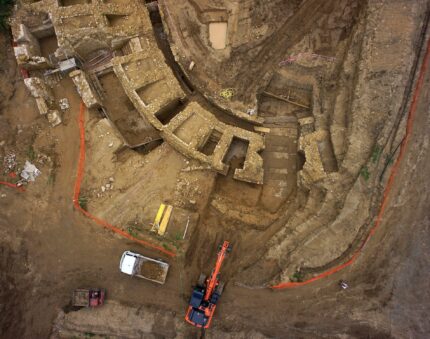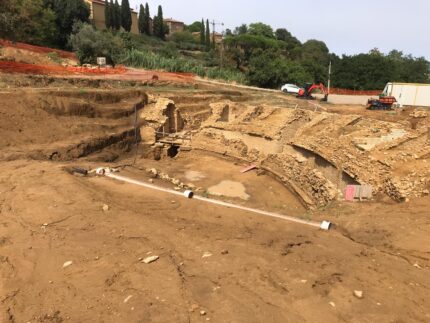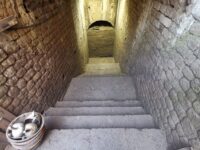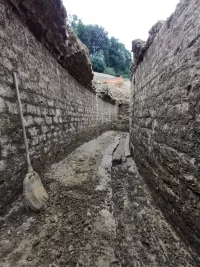 In 2015, a waterway restoration project in Tuscany’s ancient Etruscan city of Volterra stumbled on a Roman amphitheater whose existence was completely unknown. Test trenches found curved walls that indicate the full building was around 260 feet long and 200 feet wide and could seat an estimated 8,000-10,000 spectators, yet there are no surviving ancient sources that mention it and no traces of it above ground. It was completely buried and completely forgotten, earning it the title “the Amphitheater That Wasn’t There.”
In 2015, a waterway restoration project in Tuscany’s ancient Etruscan city of Volterra stumbled on a Roman amphitheater whose existence was completely unknown. Test trenches found curved walls that indicate the full building was around 260 feet long and 200 feet wide and could seat an estimated 8,000-10,000 spectators, yet there are no surviving ancient sources that mention it and no traces of it above ground. It was completely buried and completely forgotten, earning it the title “the Amphitheater That Wasn’t There.”
The amphitheater was built in the Julio-Claudian era (likely the 1st century A.D.). Nobody knows exactly how long it was in use for performances and gladiatorial games, but there is evidence (the remains of meals, hearths, coins) of it having been reused as a private dwelling in the Middle Ages. Once it was abandoned and all maintenance ceased, the burial appears to have happened quickly. The amphitheater occupied a valley that silted up rapidly, raising the ground level. The site was then used for cultivation.
 Since the discovery, the archaeological team has carried out seven excavation campaigns lasting two or three months apiece. Scraping up the money to excavate the surprise find has been challenging, with new funding for the next dig needing to be secured after each campaign. The first big chunk of change was 250,000 euros for the 2019 campaign financed by a bank. The region of Tuscany chipped in another 250,000 euros for 2020 and 2021, and Italy’s Ministry of Culture pitched in an additional 250,000 in 2021.
Since the discovery, the archaeological team has carried out seven excavation campaigns lasting two or three months apiece. Scraping up the money to excavate the surprise find has been challenging, with new funding for the next dig needing to be secured after each campaign. The first big chunk of change was 250,000 euros for the 2019 campaign financed by a bank. The region of Tuscany chipped in another 250,000 euros for 2020 and 2021, and Italy’s Ministry of Culture pitched in an additional 250,000 in 2021.
 It was money very well spent. In 2020, the excavation campaign uncovered a system of underground vaulted passageways used by spectators to reach the bleachers. The same campaign found a vaulted corridor circumnavigating the arena, known as the “cuniculo circumpodiale,” that was used by the gladiators, wild beasts and performers to enter the arena at various locations. The walls and corridors are in exceptional condition.
It was money very well spent. In 2020, the excavation campaign uncovered a system of underground vaulted passageways used by spectators to reach the bleachers. The same campaign found a vaulted corridor circumnavigating the arena, known as the “cuniculo circumpodiale,” that was used by the gladiators, wild beasts and performers to enter the arena at various locations. The walls and corridors are in exceptional condition.
 In 2022, a major infusion of 4.5 million euros from the Ministry of Culture ensured that the excavation would have sufficient funds to see the job through to the end. Digging was suspended last spring and summer while bureaucratic issues were resolved but it has now resumed and will continue uninterrupted for two years until the entire amphitheater is uncovered, the site cleared and the structures secured. The excavation has to proceed one section at a time in a clockwise direction to ensure access routes between the sectors aren’t blocked off by the digging itself.
In 2022, a major infusion of 4.5 million euros from the Ministry of Culture ensured that the excavation would have sufficient funds to see the job through to the end. Digging was suspended last spring and summer while bureaucratic issues were resolved but it has now resumed and will continue uninterrupted for two years until the entire amphitheater is uncovered, the site cleared and the structures secured. The excavation has to proceed one section at a time in a clockwise direction to ensure access routes between the sectors aren’t blocked off by the digging itself.
Follow the progress of this ground-breaking excavation on the Facebook page of “The Amphitheater That Wasn’t There.”
In the first post -linked to above- the situation is much more visible. The road in the background seems to be the ‘Viale Franco Poretti’ in Volterra.
That theater –it seems– is not a classical “amphitheater” (amphi=all around), like e.g. the Colosseum in Rome.
Thus, it is not an “Arena” with gladiators and wild beasts (etc.), but ..a theater 😀
Phenomenal discovery.
Wow, I had no idea Volterra had a surprise amphitheater! As a fellow history enthusiast, I find this incredibly fascinating. The thought of a hidden amphitheater in such a picturesque town is simply amazing. I can’t wait to learn more about its history and significance. Thank you for sharing this update!